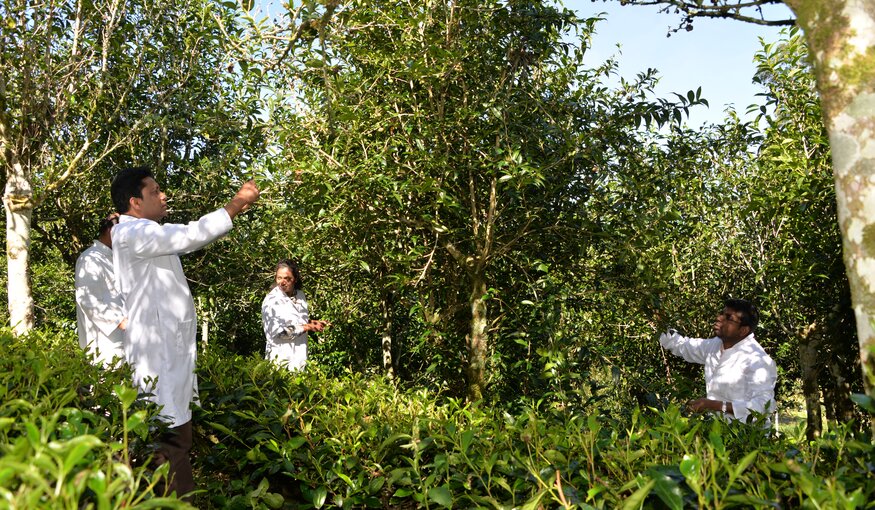Time to Serve the Tea

20 October 2020
Tea-growing countries around the world would all be better served by sharing their knowledge and plant genetic material, according to Dr. Mahasen A B Ranatunga, Head of the Plant Breeding Division and Genebank at the Tea Research Institute (TRI) in Sri Lanka.
Sri Lanka is one of the world’s largest producers and exporters of tea, an economically and socially important crop that supports the livelihoods of more than one million Sri Lankans.
To support this industry, the TRI collects and conserves tea germplasm from across the country, in order to develop new tea varieties or cultivars that can meet changing consumer demand and cope with emerging environmental challenges—a mission that depends on having a diversity of genetic material at its disposal. Their collection now contains more than 600 different types of tea in a field genebank.
TRI was one of nine national tea collections that participated in the Crop Trust-led development of the Global Strategy for the Conservation and Use of Tea Genetic Resources, which examined the state of tea diversity conservation around the world, and made recommendations for the future.
“I believe all tea-producing countries should be sharing their genetic material,” Dr. Ranatunga said. “This Global Strategy will, I hope, lead to a movement that helps us all.”

Why is it important to conserve tea diversity in Sri Lanka?
Tea was introduced here during the early 1800s by the British. Because it is not a native crop, we have very limited genetic diversity. We do not know the exact parentage of our genetic materials, we only know the geographic sources: India and China. Tea was originally introduced in the form of seeds; we call these “old-seedling teas.” Their yield is not as high as that of new varieties, but they have adapted to the regions where they grow. Most of these diverse old-seedling teas are being replaced with one or two popular, uniform cultivars (or other crops such as oil palm, which is becoming very popular). This means we are rapidly losing the original diversity in those areas, which is a major problem.
How are you using the genetic diversity in your tea collection?
When tea breeding started back in the 1930s, the main objective was increasing yield. During the 1960s and 70s, we worked towards incorporating pest and disease resistance into these high-yielding varieties. By the 1990s, we were incorporating quality traits as well. Nowadays, many new challenges are arising, such as reducing the use of pesticides.
We are also looking at abiotic stress tolerance. Drought has become a serious problem in some parts of the country. Plus, it’s hard to find skilled workers to harvest tea, so growers are seeking varieties suitable for mechanical harvesting. So we have begun to screen our germplasm in search of these traits.
We have also started a new breeding program to develop specialty tea cultivars. Some of these are white teas, others are purple teas; some are high-anthocyanin or high-polyphenol teas. We are obtaining all this material from our collection.
Lately, demand for green tea is growing, so we’ve screened our core collection and identified suitable varieties for producers.

Are there any gaps in your field genebank that you would like to fill?
Our collection is made up mostly of Cambod type teas [hybrids between the Indian var. assamica and the Chinese var. sinensis types]. This means we have only a narrow range of diversity. For example, the range of caffeine present in our varieties is limited, in terms of both low- and high-caffeine accessions. Our wish list mainly consists of China-type accessions, which are the least represented in our collection, but also assamica types.
Furthermore, Sri Lanka now frequently experiences drought and heat stress. In Kenya, they have superb teas that can withstand both drought and heat shock. Those are also on our wish list. We’d also like to explore some unique wild relatives for use in our breeding programs.
What aspects of the Global Tea Strategy stood out for you?
Conservationists and breeders working on other crops, like coffee, coconut, even rubber, have created formalized exchange programs. But, unfortunately, there are no formal mechanisms for exchanging tea diversity. We recently initiated discussions with a couple of our counterparts in other countries, but we could not make the exchange happen. If we could share diverse and unique materials globally, everybody would benefit.
For example, the shot hole borer is the leading insect problem for tea producers in Sri Lanka, but it is not a serious problem in India, Kenya, Japan, China and other tea-growing countries. Maybe one of those countries has genetic materials in their collection that has the resistant trait we need. That said, we are busy evaluating our old-seedling tea for resistance.
I have visited other germplasm collections, especially in China and Japan, and it is clear that the information and knowledge needed to properly maintain tea collections is already there, but we are not sharing them with each other. Whatever experiences we have, whatever challenges we encounter in our efforts to manage these germplasm collections, must be shared. Maintaining a germplasm collection is a huge task, here in Sri Lanka and anywhere else in the world.
I believe all tea-producing countries should be sharing their genetic material, for the benefit of us all. It is high time we reached a global understanding over tea diversity. This strategy will, I hope, lead to a movement that helps us all. Yes, we have to compete, as an industry. But we can still help each other.
The Global Strategy for the Conservation and Use of Tea Genetic Resources was led by the Crop Trust, in collaboration with the Tea Research Institute, Chinese Academy of Agricultural Sciences (TRICAAS), several other key national collection holders, and consumer goods company Unilever. Read the Strategy summary here.
- Work
Category: Tea
